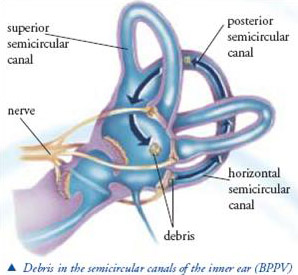
BPPV
Benign Paroxysmal Positional Vertigo (BPPV) is the most common of vestibular disorders and the most easily treated. In most patients, it can be cured with a simple physical therapy maneuver. BPPV can affect people of all ages, although it is most common in folks over the age of 60.
BPPV occurs when small, microsized calcium crystals called otoconia become dislodged from their normal location on the utricle, one of the inner ear sensory organs. These otoconia are usually embedded in a gelatin like material on top of the utricle. If the otoconia become detached, they are free to flow in the fluid filled spaces of the inner ear, including the semicircular canals which sense the rotation of the head. If there are enough otoconia floating around, they can aggregate into a larger clump. Because they are heavy, they migrate into the lowest part of the inner ear, the posterior semicircular canal. Once in the semicircular canal, they may still move when the head changes position, such as looking up or down, over the shoulder, or when rolling over in bed. It is the movement of these stones that causes an unwanted flow of fluid in the semicircular canal even after the head has stopped moving. This leads to a false sense that the head and body are spinning around or that the world around you is spinning around.
Symptoms
Patients with BPPV usually experience vertigo when they turn over in bed, get in or out of bed, look up to a high shelf or put their head back in the shower. These are circumstances where there is a large change in the orientation of the head with respect to the pull of gravity. Patients often become imbalanced or unsteady when they get up from bed and try to walk and may even fall. They are occasionally quite ill with nausea, vomiting and other motion sickness like symptoms.
The onset of BPPV may be abrupt and frightening. Patients may even think they are having a stroke. Whenever they tilt or tip their head, they can experience extreme vertigo, imbalance, and may even fall out of bed. If they are up and around and tilt their head back or forward, they can fall to the ground. The usual course of the illness is a gradual lessening of symptoms over a period of weeks to months. Occasionally the symptoms can last for years.
While the hallmark of BPPV is episodic vertigo associated with changes in head position, many patients also have a mild degree of constant unsteadiness during the periods when they are also having the recurrent attacks of positional vertigo.
BVC physical therapists are highly trained in the treatment of BPPV with canalith repositioning maneuvers. Classic BPPV is typically treated and completely resolved within one to two visits.
